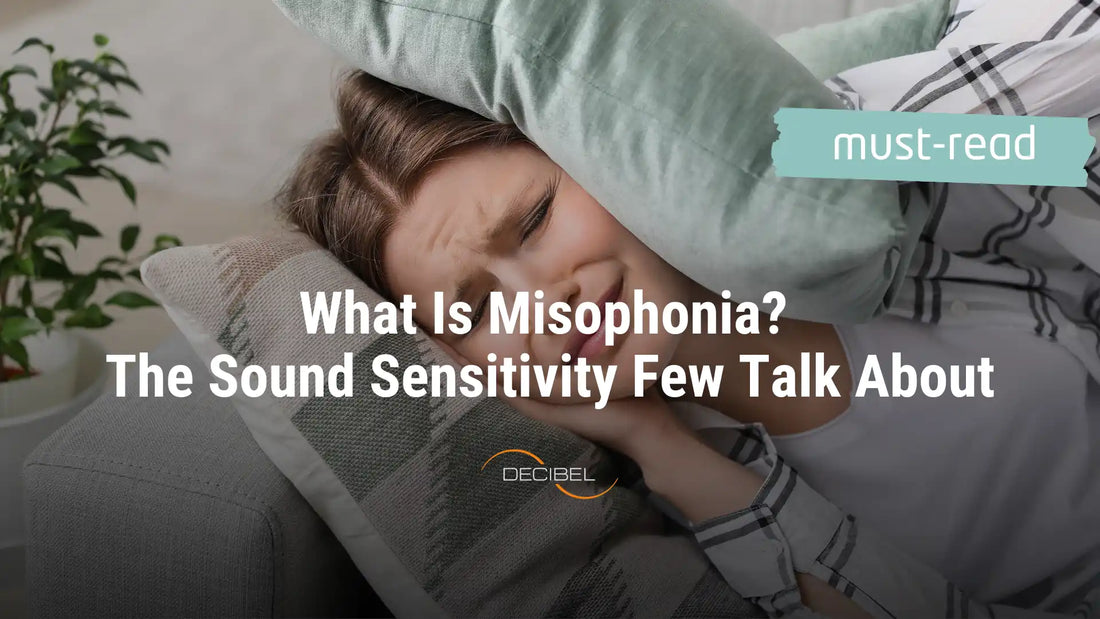
What Is Misophonia? The Sound Sensitivity Few Talk About
Nia MarkovskaShare
📖 Reading time: 5 min and 45 sec
You’re sitting in a quiet room. Someone nearby starts chewing gum, tapping their foot, or even clearing their throat every few seconds. Most people wouldn't notice, but for you, it’s impossible to ignore. That sound feels sharp and disruptive, and it is almost like it’s cutting through your focus and maybe even your patience.
If this sounds familiar to you, then you’re not being overly sensitive. You might be experiencing something called misophonia. This is a specific condition where certain everyday sounds trigger strong emotional reactions in people.
It’s still not well known and often misunderstood, but once people learn about it, things make much more sense.
Let's explore what misophonia really is, why it happens, how the brain responds to it, and how people learn to manage a world full of unavoidable, often quite loud noise.
What Exactly Is Misophonia?
Most people get annoyed by certain sounds, but not too intensely. Sounds such as loud chewing or a tapping pen. But for people with misophonia, those sounds trigger a strong, automatic emotional reaction. It can often feel like anger, strong anxiety, irritation, or in some people, even panic.
Misophonia directly means “hatred of sound.” But it’s specific and often repetitive ones, and it’s not a choice. The reaction is instant and intense, even when the person knows the sound is harmless and not ill-intended.
Defining Misophonia
Disliking noise strongly, like having misophonia, is a deeply emotional and often physical response to specific triggers. These are usually everyday human sounds, they can include:
- Chewing
- Lip smacking
- Throat clearing
- Sniffling
- Pen clicking
- Finger tapping
For someone without misophonia, those noises might not even register, but for someone who has it, they can become impossible to ignore, and nearly unbearable to tolerate.
Researchers still don’t fully agree on whether misophonia is a standalone specific condition or part of something else, like sensory processing sensitivity. But it’s increasingly being recognised in neuroscience and mental health research as a real, measurable reaction.

When Does It Start and Who Gets It?
Misophonia usually starts in childhood or early adolescence. Some people notice it after a stressful event or a period of increased sensitivity, and for others, it builds slowly over time during their adult lives.
This condition can affect people of all ages and backgrounds, and some studies suggest it may be slightly more common in women. Interestingly enough, it may also run in families, though genetics are still being studied.
Many people live with misophonia for years without knowing what it is, and they may think they’re just irritable or overreacting. But in reality, they’re having a neurological response to a sensory trigger, and they’re far from alone.
Real-Life Triggers
Misophonia is triggered by repetition, rhythm, and context. Most misophonic triggers are subtle, everyday sounds that seem harmless to most, but feel unbearable to someone with the condition.
These are not rare or unusual sounds; often, they’re the ones you encounter daily, especially in quiet spaces like offices, classrooms, or even at home.
Common Day-to-day Situations
A large-scale study in 2021 found that the most frequently reported misophonia triggers were chewing, lip smacking, throat clearing, and sniffing. Other common ones include:
- Repeated pen clicking or keyboard typing
- Foot tapping, fidgeting, or rustling clothing
- Heavy breathing or subtle humming
- Clocks ticking, cutlery scraping, or distant bass sounds
What makes a sound a trigger often depends on who makes it and where. A family member chewing may be more triggering than a stranger. A tapping pen in a quiet room feels worse than the same sound in a busy coffee shop.
Emotional Reactions
The emotional response is often immediate and intense. People report feeling:
- Irritated or agitated
- Anxious, tense, or on edge
- Distracted or mentally overwhelmed
- In some cases, even rage or panic
One study using fMRI found that people with misophonia showed increased activity in the anterior insular cortex (AIC). This is a brain region that is linked to emotional processing and salience detection when exposed to trigger sounds.
What’s important to note is that these responses aren’t a conscious overreaction. They’re automatic, and for many, trying to ignore them only makes it worse. This can lead to social withdrawal, strained relationships, and avoidance behaviors that impact day-to-day life.
What Happens in the Brain During Misophonia?
Misophonia isn’t just a personality quirk or emotional overreaction. Brain imaging studies show that people with misophonia process sound differently, especially in regions that connect hearing with emotion and threat response.

Hyperconnectivity in Brain Circuits
One of the key areas involved is the anterior insular cortex (AIC). This part of the brain helps you notice and react to things that feel emotionally important, like pain or disgust.
In a 2017 brain imaging study, researchers found that people with misophonia had increased activity in the AIC when hearing trigger sounds. But that wasn’t all; they also showed stronger connections between the AIC and regions like the amygdala, which handles fear and threat, and the hippocampus, which stores emotional memories.
This means that in misophonia, the brain reacts to it as if it were a direct threat. It’s like your brain wrongly labels a small, repetitive sound as something dangerous, and then floods your system with stress signals.
Why the Brain Misfires
We still don’t know exactly why some people develop this response, but researchers believe it’s a case of sensory-emotional overlinking. In misophonia, certain sounds become “tagged” with emotional meaning.
This response also bypasses the logical brain. That’s why someone with misophonia might feel overwhelmed by a sound they know isn’t harmful, and still can’t stop the emotional reaction. And this helps explain why typical coping strategies, such as ignoring it, don’t work. The sound doesn’t stay in the hearing center of the brain. It travels straight to the emotional core.
Living with Misophonia
There’s no cure for misophonia - yet. But that doesn’t mean people are helpless. Many find ways to manage their reactions, reduce exposure to triggers, and feel more in control of their environment.
Avoidance and Adaptation
One of the most common strategies is noise avoidance, but not in the sense of isolation. It’s about setting boundaries and designing environments that feel safe and calm.
For example:
- Using noise-canceling headphones in shared spaces can help reduce exposure to triggers without needing to leave the room.
- Playing soft ambient background or nature noise can mask repetitive or sharp sounds without overstimulation.
- In group settings, explaining the condition to trusted people can lead to more understanding and flexibility.
Some people also adapt their spaces to make them more acoustically friendly. Adding soft textures, like rugs or curtains, can reduce harsh sound reflections. But for more persistent challenges, such as echo, footsteps, or outside noise, acoustic treatment can offer real relief.
Installing acoustic panels in a bedroom or home office, for example, helps reduce sharp or repetitive reflections that make sounds feel more intense. Even a few panels can help soften the space, creating a calmer soundscape that reduces overall mental load.
Therapies and Techniques
Alongside environmental strategies, some people benefit from therapy and structured coping techniques.
- Cognitive Behavioral Therapy (CBT) can help reframe emotional reactions to sound and reduce the feeling of helplessness
- Mindfulness and breathing exercises help regulate stress in moments when triggers can’t be avoided
- In some cases, exposure therapy, done with professional support, can gently reduce the emotional charge linked to specific sounds
Support groups and online communities have also become valuable spaces for sharing ideas, resources, and validation.
Why Misophonia Matters
Misophonia isn’t just a personal quirk. It affects relationships, concentration, self-esteem, and daily functioning. But because it’s invisible, and triggered by sounds others barely notice.
People with misophonia are sometimes told to stop overreacting, but these reactions ignore what’s really happening: a neurological response, not a choice. It’s a disconnect between sound and safety, one that the brain feels deeply.
This misunderstanding leads to isolation, and people might avoid shared meals, struggle in classrooms or open offices, or dread public transport. The more they feel misunderstood, the harder it becomes to ask for space or support.

Misophonia is real. It’s measurable in the brain, felt in the body, and deeply emotional. But it doesn’t have to define someone’s life.
The more we understand about how the brain responds to sound, the more tools we have to protect our peace. That includes therapies, boundaries, and yes, thoughtful acoustic design. A calm, well-balanced environment isn’t just about silence. It’s about giving your brain the conditions it needs to feel safe.
Whether you live with misophonia or love someone who does, the message is simple:
You’re not overreacting. And you’re not alone.
Additional Reading & References:
-
Edelstein, M., Brang, D., Rouw, R., & Ramachandran, V. S. (2021). Misophonia: Physiological investigations and case descriptions. Frontiers in Neuroscience, 15, 643609.
-
Kumar, S., Tansley-Hancock, O., Sedley, W., Winston, J. S., Callaghan, M. F., Allen, M., ... & Griffiths, T. D. (2017). The brain basis for misophonia. Current Biology, 27(4), 527–533.




